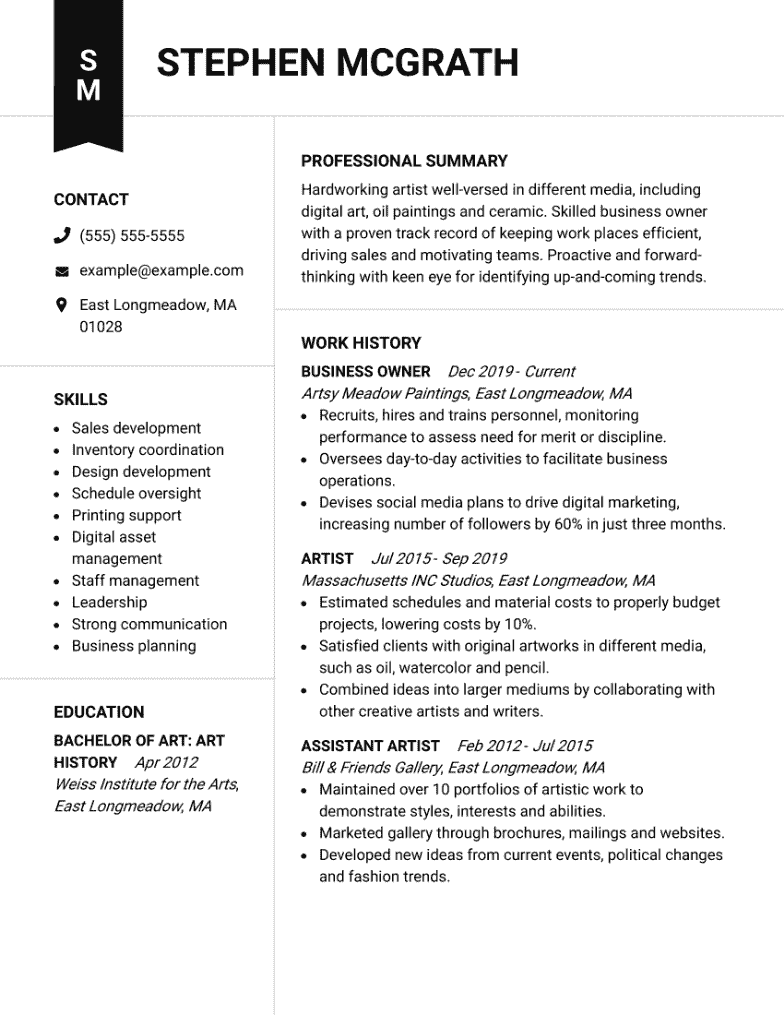Stunning artist CV examples to use this year
Stand out from the crowd and showcase your artistic skills and competencies. Use our artist CV examples to help get you there.
Stand out from the crowd and showcase your artistic skills and competencies. Use our artist CV examples to help get you there.





OUR USERS HAVE BEEN HIRED BY

Many artists showcase their artistic competencies through portfolios that include their best work. Though, that doesn’t mean they don’t have their CVs like all other professions. A professional artist’s CV is as important as their portfolio when it comes to getting a job in the fine arts.
But, an artist’s CV also contains elements that are different compared to CVs in other professions. They use it to showcase their work experience and competencies. But, they also use art CVs to showcase their portfolios, productions and exhibitions.
You should follow a different set of guidelines when it comes to writing your artist CV. This is true whether you’re applying for an art exhibition or a job position as an art director at an art gallery.
Think of your artist CV as your sales pitch to potential employers. It accomplishes the following:
This article will walk you through the essential elements you should highlight on your artist’s CV. We’ll then take an in-depth look at the structure of an artist’s CV. Then, we’ll go over some essential dos and don’ts to keep in mind when crafting the perfect artist CV.
An artist’s CV can contain other elements depending on your field of art. This can include a list of exhibition works, music events, or theatre productions. An artist’s CV can include links to online portfolios of artwork, as well. They can also contain bibliographies that showcase or critique their work.
What you should highlight on your artist CV will largely depend on the field of art you’re in. A painter’s CV can highlight gallery exhibitions, solo exhibitions or juried exhibitions. An actor’s artist CV can highlight productions they’re involved in, such as theatre, commercials, TV or film.
An artist’s CV structure can vary depending on the field of art and CV format. Though, all artist CVs are in one of the three most popular CV formats:
No matter the CV format you choose, your CV should contain these essential elements:
Your artist CV header should catch the attention of recruiters and be easy to follow. It’s important to keep in mind that employers will often use applicant tracking systems (ATS) to scan CVs. you should format your header with ATS in mind. The header includes the following information:
The CV summary statement appears below the header, and is a few sentences long. It encapsulates an artist’s statement that sums up your career path, relevant skills, accomplishments and experience. An artist’s professional summary sets the theme for the remainder of the CV. Use this to impress potential employers with your top skills and achievements here.
Your education section should include any relevant education, certifications or professional training you’ve received, starting with the most recent.
Your skills section should showcase your artistic skills as they are relevant to the position or exhibition you’re applying for. For example, because the art field is varied, a musician’s required skills can vary significantly from what skills an actor showcases. Regardless of their art field, there are some skills virtually all artists can showcase on their professional CVs:
Your artist’s CV work history should showcase your professional experience, starting with your current or most recent job and working your way down. For each job, list three to five achievements or recognitions you’ve earned. You can include freelance work here, as long as it applies to your field of art and is relevant to what you’re applying for.
The bibliography section showcases reviews of an artist’s work, articles about their work and any relevant media interviews. These elements can be included in the exhibition section as well. If you decide to make your bibliography a separate section, place it before the exhibition section.
The exhibition section should be used to list events where you’ve showcased your artistic work, as they are relevant to the position, exhibition or affiliation you’re applying for. Depending on the field of art you’re in, this section can also be called “productions” for actors, for example. You can include online portfolios of your creative work in this section.
Below is a list of some valuable dos and don’ts when it comes to crafting the perfect artist CV:
In the UK, an artist resume and an artist CV are the same. It’s a document that showcases an artist’s skills, work experience and education. In the U.S., a resume and a CV are two separate documents; the resume is a brief overview of a candidate’s professional history and is usually requested for job applications, while a CV is a detailed overview of someone’s career and is more commonly found in specialised fields like academia, law or sciences.
Use a functional CV format for your artist’s CV if you don’t have much experience. Focus on relevant extracurricular projects or art pieces you’ve created that can relate to the position or exhibition for which you’re applying. Place a more significant focus on the art that you can showcase in your bibliography.
Review the art job description or exhibition application to pull out relevant keywords connected to skills and experiences, then update your CV to emphasise. Then tailor your art skills, experience, exhibitions and productions to match what the job posting is seeking.
We personalize your experience.
We use cookies in our website to ensure we give you the best experience, get to know our users and deliver better marketing. For this purpose, we may share the information collected with third parties. By clicking “Allow cookies” you give us your consent to use all cookies. If you prefer to manage your cookies click on the “Manage cookies” link below.